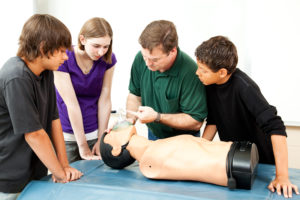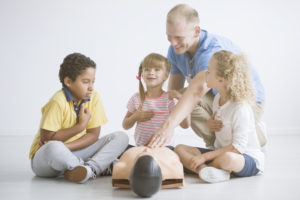Your cart is currently empty!
The Importance of First Aid in your School Curriculum
 Knowing how and when to provide medical care to someone who is hurt is very important. Helping someone right away can make a difference in their recovery from their injuries. Some injuries can get worse if we don’t act right away. Even providing emotional support while waiting for trained responders to arrive can help an injured child feel more comfortable and less afraid about the accident. When we provide first aid right away, we can stop bleeding or prevent someone from moving, protecting them from accidentally making their injury worse.
Knowing how and when to provide medical care to someone who is hurt is very important. Helping someone right away can make a difference in their recovery from their injuries. Some injuries can get worse if we don’t act right away. Even providing emotional support while waiting for trained responders to arrive can help an injured child feel more comfortable and less afraid about the accident. When we provide first aid right away, we can stop bleeding or prevent someone from moving, protecting them from accidentally making their injury worse.
When you take first aid training, you will learn about treating common illnesses and injuries. This helps students become more aware of determining if an injury is severe or minor. Education and training will boost students’ confidence and help them become more comfortable and confident in their skills.
The first step in any medical situation is to determine if the scene is safe for you to enter. You do not want to become another person who is injured or ill, so look for any potential dangers. Don’t touch the person if it is not safe to do so, instead call for help.
After determining the problem and making sure the scene is safe, the next step in providing help is to assess the responsiveness of the injured or ill person. The best way to determine this is to tap the person and loudly shout, “Are you okay?” After determining their responsiveness, yell for help. When you are at school, know where the first aid kit and the AED are kept, be familiar with their contents, and understand how to activate the Emergency Medical Services (EMS) in your area.
If the person is responsive but needs first aid, knowing how to treat common injuries and illnesses will help until a Medical Responder arrives. First aid is divided into two categories: Illnesses and Injuries.
Common childhood illnesses are asthma, anaphylaxis, and diabetes. Most children know that they have one of these medical conditions and will tell you about them if you ask ahead of time. Asthma is the most common chronic condition among children. It is a chronic lung disease that makes it harder to move air in and out of your lungs and can start at any age. When a child with asthma is exposed to one of their triggers, it can cause the insides of their airways to swell even more. The swelling narrows the space for air to move in and out of the lungs. Triggers could be the common cold, stress, changes in the weather, or things in the environment, such as dust, chemicals, smoke, and pet dander. When a friend is having an asthma attack, it is important to help them sit down and use their inhaler-prescribed medication for their lungs. You can help move them out of the way of the trigger if it is something in the air or a pet.
Anaphylaxis is a severe, potentially life-threatening allergic reaction with a progressive series of signs and symptoms. This medical condition can cause symptoms in any part of the body, but look for:
- swelling of throat
- breathing difficulties
- an itching rash or hives
- shock and/or passing out
When you think someone is having anaphylaxis, help them get out their Epi-Pen or Epinephrine auto-injector and help inject the medicine into their upper leg. This medicine will help open up their airways and breathe easier until help arrives.
Diabetes is a chronic health condition that affects how your body turns food into energy. There are several types, but kids need to be concerned about Type I, which is diagnosed during childhood. In Type I Diabetes, the body doesn’t produce enough insulin, a hormone made by the pancreas that allows your body to use sugar (glucose) from carbohydrates in the food you eat. Some signs to look out for that could mean you have developed Type I Diabetes are always being thirsty or hungry, losing weight, being tired, and urinating a lot. Be sure to tell a doctor if this happens.
When someone you know has diabetes, they can suddenly suffer from high blood sugar or low blood sugar and feel unwell. In this instance, some signs to watch for are dizziness, shakiness, headaches, cool and/or moist skin, changes in behavior, and confusion. If your friend feels they have low blood sugar, you can offer them a sugary drink or snack to help them feel better. Some good choices are fruit juices, sodas (with sugar, not diet), raisins, small candies, or sugar tablets.
 Several common injuries for school-age children are cuts or lacerations, sprains or broken bones, burns, heavy bleeding, or head injuries. For all cuts or injuries involving bleeding, immediately put pressure on the wound with any clean cloth or gauze you have. If you can, put on gloves ahead of time, this is safer for all. If it is a small cut that stops bleeding on its own, you can wash the area with antibacterial soap and clean water and then bandage it. If it continues to bleed, continue applying pressure and call for help. You may need to use additional gauze, but don’t remove the original bandage as this can make it bleed more. Cuts over a half-inch long (1.25 cm), are deep or wide, are dirty, or don’t stop bleeding will need to get stitches.
Several common injuries for school-age children are cuts or lacerations, sprains or broken bones, burns, heavy bleeding, or head injuries. For all cuts or injuries involving bleeding, immediately put pressure on the wound with any clean cloth or gauze you have. If you can, put on gloves ahead of time, this is safer for all. If it is a small cut that stops bleeding on its own, you can wash the area with antibacterial soap and clean water and then bandage it. If it continues to bleed, continue applying pressure and call for help. You may need to use additional gauze, but don’t remove the original bandage as this can make it bleed more. Cuts over a half-inch long (1.25 cm), are deep or wide, are dirty, or don’t stop bleeding will need to get stitches.
If you suspect a sprain or fracture or the child won’t use their injured arm or leg, apply ice for 20 minutes, and wrap with an ace bandage. Elevating the appendage helps lower the swelling. You may need to call for help or see a doctor if it continues to hurt and certainly if you see any deformity. Burns can come from various sources, including thermal, electrical, and chemical. Ensure that the person is removed from the source, and then run cool water over their burn. If it is minimal, you should bandage it and keep it clean. It should heal in a few days. Burns that blister or look charred (white or black skin) or located on the face, ears, hands, feet, or genital area need to be examined by a doctor immediately so that permanent damage can be avoided.
Head injuries are severe. If a child falls or is hit in the head, suspect a head injury. Look for a headache, sensitivity to noise and light, irritability, confusion, lightheadedness and/or dizziness, problems with balance, nausea, problems with memory and/or concentration, or blurred vision. All head injuries need immediate medical attention. Do not move the child if possible. If they have already gotten up, have them lay down in a comfortable position until an ambulance arrives.
Handwashing is essential in the prevention of disease and illness. Wash your hands after each episode of care and after taking off gloves. When a sink is not available, use hand sanitizer. (Most hand sanitizers are alcohol-based and substitutable for handwashing when needed.)
There are many situations where first aid will be required in a school setting. If more adults and children are trained in this subject, future injuries can be treated with ease. Share your experience in First Aid training at school.
4 responses
-
-
Of course! We are happy to hear you enjoyed it.
-
-
This is a great article, Kimberley! Having a school emergency kit is essential, but it’s also important for students to know the basic first aid. Just a question though, for fractures, are there any alternatives if there is no ice available?
-
Hello there, thank you for your question! I am glad you found this article useful. Fractures need medical attention, so the first step would be to call 911 or head to the emergency room, if safe to do so by car. If you are calling 911, do not move the person; let them rest in a comfortable position and wait alongside them for the ambulance to arrive. If no ice is available, it should only be a few minutes until the ambulance arrives. If it is safe to transport the person by car and the fracture is only minor, like a finger or toe, then you can attempt splinting with tape and any straight object, like cardboard or a magazine. Once home, ice is great for recovery!
-







Thank you for sharing this information with the community.